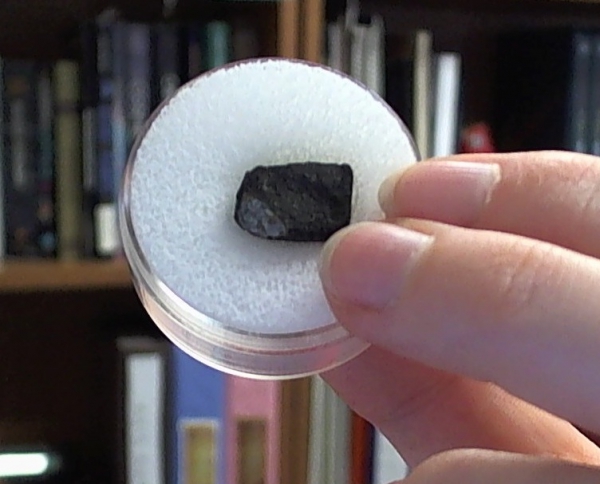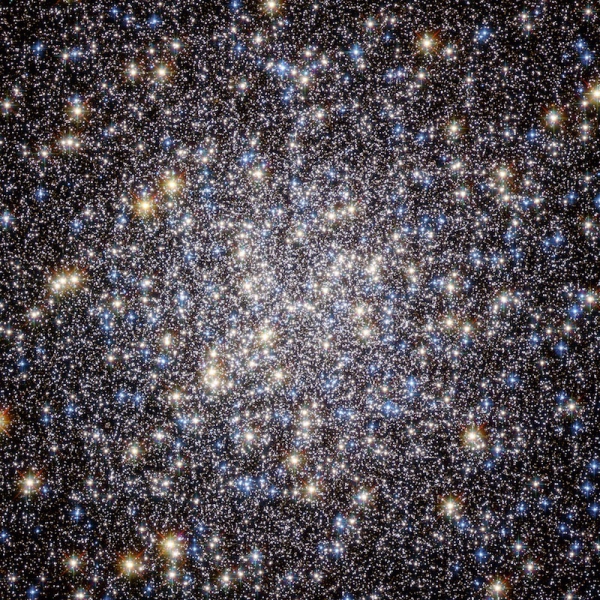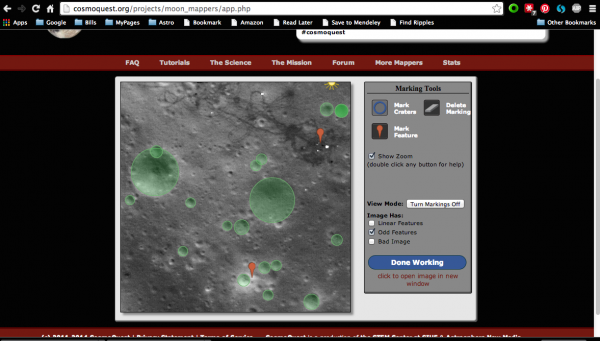by Nicole Gugliucci
- Published: Wednesday, April 02 2014 13:20
Want to really get back to your roots? Experience the ancient? Try astronomy!
Only through space can you experience the oldest things that the Universe has to offer. Ever see a meteorite in a museum? Many meteorites are full of chondrules, or tiny inclusions of rock that solidified at the very beginning of the Solar System 4.5 billion years ago. Maybe you've even gotten to hold such a meteorite? It's probably the oldest thing you will ever touch.
A tiny piece of the Chelyabinsk meteorite. Credit: Nicole Gugliucci
Astronomy lets you travel back in time as well. Thanks to the speed of light being a finite, measurable quantity, it actually takes time for the light to reach us from, well, just about anything. Light from the Sun takes 8 minutes to reach us from the surface, but it also takes 170,000 years for light to get from the center to the surface thanks to the random walk, or "bouncing around" that photons do inside the star.
The light or photons emitted from an object in space can travel for a very long time before hitting your retinas to allow you to see them. Stars in our local neighborhood of the galaxy may travel for hundreds or thousands of year. The furthest thing you can see with your naked eye on a dark, clear night is the Andromeda Galaxy. If you look in just the right place in the sky, you might catch the fuzziness of that great spiral galaxy, knowing that the light took over 2 million years to reach you. Pretty awe-inspiring.
The Heart of the M13 Globular Cluster. Credit: ESA/Hubble and NASA
With a little help from a small telescope, you can see some of the very oldest structures in the Universe. Globular clusters are compact groups of hundreds of thousands of stars that have been around since nearly the beginning of the Universe. The stars are up to 13 billion years old, though not quite from the first generation of stars. But when you press your eye up to the eyepiece of a telescope and look at a globular cluster like M13, that is the oldest thing you'll ever see with your own eyes.
The oldest light we've ever been able to see is from the Cosmic Microwave Background (CMB), the remnant radiation that escaped a dense Universe just 380,000 years after the Big Bang. You might not be able to see the CMB with your eyes, since it is strongest at a much longer wavelength than what your eye can see. But the CMB bathes us from every direction in radio waves, so much so that some tiny percentage of your TV and radio static comes from the CMB itself. (Very, very tiny... but a nice thought.)
A Lunar Reconnaissance Orbiter image near an Apollo landing site, as marked by Moon Mappers. Credit: NASA/LRO/CosmoQuest
The Earth is full of historical landmarks and old features, but for truly ancient surfaces, just take one look up at our neighbor the Moon. With no plate tectonics to refresh the surface, some of the most ancient lunar highlands date back to over 4 billion years. The very history of the lunar surface is written all over it in the mountains, lava flows, and craters. We're just beginning to map the millions and millions of craters on the surface of the Moon with CosmoQuest, so you can help us uncover the history of the Moon.
Just beyond the Earth lies the history of the Solar System and the history of us. We're a part of the Universe and connected to it through physics and chemistry. Take some time this Global Astronomy Month to examine a meteorite, look at a globular cluster, or map a few craters to explore your own history through the night sky that connects us.
###
 Dr. Nicole Gugliucci is a postdoctoral astronomer and educator with CosmoQuest. Now at Southern Illinois University Edwardsville, she did her PhD in astronomy at the University of Virginia and the National Radio Astronomy Observatory and hugs just about every radio telescope she can find.
Dr. Nicole Gugliucci is a postdoctoral astronomer and educator with CosmoQuest. Now at Southern Illinois University Edwardsville, she did her PhD in astronomy at the University of Virginia and the National Radio Astronomy Observatory and hugs just about every radio telescope she can find.











Comments